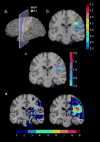Improvement after constraint-induced movement therapy is independent of infarct location in chronic stroke patients
- PMID: 19461024
- PMCID: PMC2745936
- DOI: 10.1161/STROKEAHA.109.548347
Improvement after constraint-induced movement therapy is independent of infarct location in chronic stroke patients
Abstract
Background and purpose: Disruption of the corticospinal tract at various locations in the brain has been shown to predict worse spontaneous motor recovery after stroke. However, the anatomic specificity of previous findings was limited by the categorical classification of infarct locations. Here we used computational methods to more precisely determine the specific anatomic locations associated with impaired motor ability. More important, however, our study also used these techniques to evaluate whether infarct location could influence motor outcomes after Constraint-Induced Movement therapy (CI therapy), a specific and controlled form of physical therapy.
Methods: Quantitative voxel-based analyses were used to determine whether infarct location could predict either initial motor ability or clinical improvement after CI therapy in chronic stroke patients.
Results: Although corona radiata infarcts were associated with worse in-laboratory motor ability at pretreatment, infarct location did not predict improvement in either the laboratory or the life situation after CI therapy.
Conclusions: The extent of improvement from CI therapy does not depend on the location of neurological damage, despite there being a pretreatment relationship between infarct location and in-laboratory motor ability. This dissociation could be explained by brain plasticity induced by CI therapy.
Conflict of interest statement
Figures



Similar articles
-
Atrophy of spared gray matter tissue predicts poorer motor recovery and rehabilitation response in chronic stroke.Stroke. 2012 Feb;43(2):453-7. doi: 10.1161/STROKEAHA.111.633255. Epub 2011 Nov 17. Stroke. 2012. PMID: 22096036 Free PMC article.
-
Motor recovery from constraint induced movement therapy is not constrained by extent of tissue damage following stroke.Restor Neurol Neurosci. 2014;32(6):755-65. doi: 10.3233/RNN-130366. Restor Neurol Neurosci. 2014. PMID: 25189180
-
MRI infarction load and CI therapy outcomes for chronic post-stroke hemiparesis.Restor Neurol Neurosci. 2008;26(1):13-33. Restor Neurol Neurosci. 2008. PMID: 18431003 Clinical Trial.
-
Can repetitive transcranial magnetic stimulation enhance motor outcomes in cerebral infarct patients?J Integr Neurosci. 2020 Mar 30;19(1):119-123. doi: 10.31083/j.jin.2020.01.20. J Integr Neurosci. 2020. PMID: 32259892
-
Motor recovery after stroke: lessons from functional brain imaging.Neurol Res. 2002 Jul;24(5):453-8. doi: 10.1179/016164102101200320. Neurol Res. 2002. PMID: 12117313 Review.
Cited by
-
Cortical thickness and metabolite concentration in chronic stroke and the relationship with motor function.Restor Neurol Neurosci. 2016 Sep 21;34(5):733-46. doi: 10.3233/RNN-150623. Restor Neurol Neurosci. 2016. PMID: 27258945 Free PMC article.
-
Reduced Upper Limb Recovery in Subcortical Stroke Patients With Small Prior Radiographic Stroke.Front Neurol. 2019 May 8;10:454. doi: 10.3389/fneur.2019.00454. eCollection 2019. Front Neurol. 2019. PMID: 31133963 Free PMC article.
-
Forced arm use is superior to voluntary training for motor recovery and brain plasticity after cortical ischemia in rats.Exp Transl Stroke Med. 2014 Feb 14;6(1):3. doi: 10.1186/2040-7378-6-3. Exp Transl Stroke Med. 2014. PMID: 24528872 Free PMC article.
-
Atrophy of spared gray matter tissue predicts poorer motor recovery and rehabilitation response in chronic stroke.Stroke. 2012 Feb;43(2):453-7. doi: 10.1161/STROKEAHA.111.633255. Epub 2011 Nov 17. Stroke. 2012. PMID: 22096036 Free PMC article.
-
Size doesn't matter: cortical stroke lesion volume is not associated with upper extremity motor impairment and function in mild, chronic hemiparesis.Arch Phys Med Rehabil. 2013 May;94(5):817-21. doi: 10.1016/j.apmr.2013.01.010. Epub 2013 Jan 18. Arch Phys Med Rehabil. 2013. PMID: 23337427 Free PMC article.
References
-
- Shelton FN, Reding MJ. Effect of lesion location on upper limb motor recovery after stroke. Stroke. 2001;32:107–112. - PubMed
-
- Pennisi G, Alagona G, Rapisarda G, Nicoletti F, Constanzo E, Ferri R, Malaguarnera M, Bella R. Transcranial magnetic stimulation after pure motor stroke. Clin Neurophysiol. 2002;113:1536–1543. - PubMed
-
- Kwon YH, Lee MY, Park JW, Kang JH, Yang DS, Kim Y, Ahn SH, Jang SH. Differences of cortical activation pattern between cortical and corona radiata infarct. Neurosci Lett. 2007;417:138–142. - PubMed
-
- Fries W, Danek A, Scheidtmann K, Hamburger C. Motor recovery following capsular stroke. Brain. 1993;116:369–382. - PubMed
-
- Dawes H, Enzinger C, Johansen-Berg H, Bogdanovic M, Guy C, Collett J, Izadi H, Stagg C, Wade D, Matthews PM. Walking performance and its recovery in chronic stroke in relation to extent of lesion overlap with the descending motor tract. Exp Brain Res. 2008;186:325–333. - PubMed
Publication types
MeSH terms
Grants and funding
LinkOut - more resources
Full Text Sources
Medical

